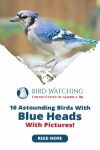
What’s This Post About?
Starting the day hearing tiny birds chirping outside early in the morning makes the day much better. Often you may hear and see many types of different birds but it is likely that you will fail to recognize them.
In the United States, many birds can be found, varying in size and color. Each one of them is beautiful in their own way and can be a pleasure to see hopping around in your backyard. This is especially true for blue-headed birds that are so stunning.
There are many birds with blue heads. Some of the most common ones include Blue Jay, Eastern Bluebird, Lazuli Bunting, Woodhouse’s Scrub-Jay, Purple Sunbird, Common Grackle, Western Bluebird, Indigo Bunting, Blue Grosbeak, Cliff Swallow, Purple Martin, Mountain Bluebird, and Tree Swallow.
Which Stunning Birds Have Blue Heads?
As you read ahead, you will get to know more about some mesmerizing blue-headed birds that you may notice in your backyard but do not know much about yet. This is not a list of all the birds found with different shades of blue on them but most that you may see around frequently.
If you reside in North America and want to know more about these birds, then this field guide from Amazon can add vastly to your knowledge.
National Geographic Field Guide to the Birds of North America
Perfect for beginning to advanced birders, it is the only book organized to match the latest American Ornithological Society taxonomy.
Here is a list of 16 birds that can be found with hints of blue on them. Some have a faded blue color while others appear to be bright blue. Let us read into the list and then go on to discover each of them individually.
| Names | Scientific Names |
|---|---|
| Blue Jay | Cyanocitta cristata |
| Eastern Bluebird | Sialia sialis |
| Lazuli Bunting | Passerina amoena |
| Woodhouse’s Scrub-Jay | Aphelocoma woodhouseii |
| Purple Sunbird | Cinnyris asiaticus |
| Common Grackle | Quiscalus quiscula |
| Western Bluebird | Sialia mexicana |
| Indigo Bunting | Passerina cyanea |
| California Scrub-Jay | Aphelocoma californica |
| Blue Grosbeak | Passerina caerulea |
| Cliff Swallow | Petrochelidon pyrrhonota |
| Purple Martin | Progne subis |
| Tree Swallow | Tachycineta bicolor |
| Black-Throated Blue Warbler | Setophaga caerulescens |
| Cerulean Warbler | Setophaga cerulea |
| White-Breasted Nuthatch | Sitta carolinensis |
FUN FACT
Birds do not have teeth; they have to swallow their food whole instead of biting into it. An organ called a gizzard helps them to grind and digest their food properly!
1. Blue Jay

Blue Jays are different from all the other bluebirds seen. They have vibrant features and can be seen all year round, mainly in the eastern part of the United States. They are one of the loudest jays and are also identified as feeder bullies.
How to identify a Blue Jay?
- Have pretty rounded- wings with a white, black, and light blue pattern on their wings.
- Small in size with a long tail.
- Have black stripes on their blue face and around the eyes.
WEIRD FACT
Blue Jays tend to rub ants on their feathers to remove the formic acid, found on ants, before eating them up. This practice is known as anting!
2. Eastern Bluebird

Eastern Bluebirds are small round-headed birds with large eyes and a plump body. The male bluebirds have blue on their wings and head while the female bluebird is more of a grayish-blue shade from their head area.
They can usually be located in areas that are not too high as they search the ground for food and drop down to peck on insects.
How to identify an Eastern Bluebird?
- Long wings and short legs.
- They comprise a deep blue head.
- Have a blob of rusty orange color on the throat and chest.
PRO-TIP
In winters, bluebirds look for berries and fruits for food, if you want to attract them to your backyard, planting trees and shrubs will be a good idea!
3. Lazuli Bunting

Lazuli Buntings sit in an upright posture and are usually found on low branches and shrubs. These birds can be found in suburban gardens and fencerow fields during the breeding season.
How to identify a Lazuli Bunting?
- Males are bright blue with a pumpkin-colored breast and white stomach.
- Wings and tails are tinted with a blue shade.
- Female buntings are of a grayish brown shade in the upper portion with a blue tail and wing bars.
FUN FACT
Male Lazuli buntings sing only one song whether they are two years old or more. It comprises a series of varying syllables, unique to them individually!
4. Woodhouses’ Scrub-Jay

These are loud and inquisitive little creatures, found usually in high trees and wires. While taking flight, they seem to go slow with several glides mixed with fluttering.
How to Identify a Woodhouse Scrub-Jay?
- A medium-sized bird with a long tail.
- The bill is straight and long with a pointy edge.
- The head is a mixture of light blue and gray.
- A white throat and gray-blue belly.
FACT
A group of jays can be called a ‘scold’, ‘party', ‘cast’ and ‘band’ of jays!
5. Purple Sunbird

These are small birds that feed mainly on nectar and insects. They are usually found in pairs. The males flutter their wings in front of the female birds while singing when they are ready to breed.
How to identify a Purple Sunbird?
- Breeding males are metallic blue with a purplish shade on their entire body.
- Maroon feathers on the breast.
- Female is olive in the upper parts and yellow in the lower parts.
- Non-breeding males are of olive-brown shade with black above and yellow below.
DID YOU KNOW?
Sunbirds can live up to 16 years!
6. Common Grackle

Common Grackles are similar to blackbirds but larger. They have the same size as a mourning dove. They are mostly seen in large flocks. Common Grackles rely on their long legs for pecking food off the ground.
How to identify a Common Grackle?
- Large blackbirds with long tails and legs.
- Flathead with a downward curved bill.
- Glossy bluish-purple head with a bronze-toned body.
- Bright golden eyes.
BACKYARD TIP
To attract Common Grackles to your backyard, set up bird feeders with mixed grain and seeds!
7. Western Bluebird

These birds are similar to eastern bluebirds but vary in color. The male western bluebirds have blue shaded throats while the male eastern bluebirds have orange shaded throats. These birds are very social and hunt for food in flocks during the non-breeding season.
How to identify Western Bluebirds?
- They are chunky birds with straight, thin bills.
- Tails are shorter than the wings.
- Shiny blue heads with a rusty shade from the breast to the upper back area.
- Females have a grayish-blue head with a rusty color on the breasts.
- The lower belly is white while the tail and wings have a blue tint on them.
INTERESTING FACT
Western bluebirds weigh only an ounce. They require 155 calories to survive per day and 23 calories if they are raising their babies!
8. Indigo Bunting

Indigo Buntings are small-sized birds that are found on shrubs, treetops, and wires during the summer. They move in large flocks when migrating. These species usually consume seeds, insects, and berries.
How to identify Indigo Buntings?
- Roughly the size of a sparrow.
- Short, rounded tails which move constantly while they perch.
- Bills are short and thick.
- A breeding male is fully blue. The head has a darker blue shade with a silverish bill.
- Females are of a brownish tone with streaks of blue on the breast, wings, and tail.
BACKYARD TIP
To attract Indigo Buntings to your yard, you can set up thistles or Nyjer seeds!
9. California Scrub-Jay

Similar to other scrub jays but the difference in colors and patches can be observed in all. They usually look for high areas to sit on and are native to western North America.
How to identify California Scrub-Jays?
- Large with tall and thin dimensions.
- Hunched back posture.
- The bill is straight with a hook-like shape at the tip.
- They have a rich blueish-gray head, back, and tail.
- The underside is white with a blue neckline.
FUN FACT
These species are mischievous and have been caught stealing acorns. When stealing they check that no other Jays are watching them!
10. Blue Grosbeak

Blue grosbeaks are attracted to areas with grains and shrubs. A shrubby backyard is one where they might visit frequently. Male grosbeaks sing during the summers. They often twitch their tail sideways which can make them easily identifiable.
How to identify Blue Grosbeaks?
- A thick, large, and triangular bill.
- Males are rich blue.
- Black prints on the wing bars and in front of the eyes.
- The beak is of a black-silver shade.
- The blue color is darker on the head and faded on the underparts.
COOL FACT
Evidence states that Blue Grosbeaks are the closest relatives of Lazuli Buntings!
11. Cliff Swallow

Cliff Swallows are small admirable creatures and can be spotted in your backyard with their bright glowing forehead. They are always found in large groups and prefer building nests under bridges or on cliff ledges.
How to identify Cliff Swallows?
- A small head with round-broad wings.
- The tail is of a medium length and is of a square shape.
- They have dark metallic blue backs, starting from the top of the head.
- Their lower face area is of brick red color which fades and turns into a brownish shade in the lower body.
- The forehead has a white patch.
DID YOU KNOW?
When a Cliff Swallow is unable to find food, it watches its neighbor and follows it when it leaves for a food hunt!
12. Purple Martin

Purple Martins are colonial. Many martins are usually found nesting in the same place. They fly swiftly with a mixture of flapping and drifting. They often feed and hunt insects in the air.
How to identify Purple Martins?
- Large in size; larger than a sparrow and smaller than a robin.
- They have short tails with a fork-like shape.
- Long and narrow wings.
- Bills are slightly hooked from the edge.
- Males are dark blue-purple shade, with brown-black shaded wings.
- Females and young are dull in color with a grayish-blue shade on the head and a white belly.
BACKYARD TIP
If you place crushed eggshells in your yard, it becomes a source of grit for digesting insect exoskeletons for the martins!
13. Tree Swallow

Tree Swallows usually sustain small insects that they catch during their acrobatic flight. When the breeding season ends, they create a large flock and migrate. In non-breeding seasons, they come together to form roosts.
How to identify Tree Swallows?
- Small-sized birds; smaller than a sparrow.
- Short fork-like tail.
- Long and pointy tapered wings.
- A flat and tiny bill that is pointed from the edge.
- Males have a blue-green upper area with a bright white lower area.
- Feathers are of a blackish shade and they have a black tint around their eyes.
- Females have a duller shade with a brownish upper part.
COOL FACT
Tree swallows have helped researchers make progress in several aspects of ecology. These species are known to be the best-studied species so far!
14. Black-throated Blue Warbler

A unique bird covered with three different colors. They feed on insects that are found in the undersides of leaves.
How to identify Black-throated Blue Warblers?
- Small birds, approximately the size of a sparrow or smaller.
- Relatively large and a bit plump as compared to other warblers.
- Males comprise of a midnight blue above from the face to the back area.
- The face, throat, and wings have blobs of black.
- The lower body is of a white shade.
- Females are of a gray shade overall and have hues of blue on the tail and wings.
- Both have a small white square on the wing.
FUN FACT
Male and female birds of this particular species look extremely different and initially, they were categorized as two different species!
15. Cerulean Warbler

Cerulean Warblers are small, pretty creatures. In the spring and summer seasons, they create a loud buzz which makes them easy to identify.
How to identify Cerulean Warblers?
- Small in size.
- Short, round and pointed bill.
- A small, thin tail that is shorter than other warblers.
- Males have a sky-blue shade with streaks of blue and black at the back.
- White wings with streaks of black.
- A thin blue neckband.
- Females are more of a bluish-green shade on the upper side.
- The lower area is of a yellowish-white shade.
- Females often do not have black streaks on the sides or a neckband.
- Females have two sets of white eyebrows-like structures.
DID YOU KNOW?
When the first nest of a cerulean warbler fails, it recreates the second one with spider web found on the old nest!
16. White-breasted Nuthatch

White-breasted nuthatches are small, active birds that are quick to respond. They can adjust themselves according to the surface they walk on, for example, they turn upside down or sideways on vertical surfaces.
How to identify White-breasted Nuthatches?
- Small in size with a large head and no visible neck.
- A very short tail.
- Bill is thin, straight, and slightly curved upwards from the edge.
- Gray-blue colored back with a plain bottom and face.
- A very dark shade of blue is present on the top of the head.
- Can observe a brownish shade under the tail.
USEFUL TIP?
If you want to attract White-breasted Nuthatches, then you can leave out some large nuts such as peanuts or sunflower seeds in your yard!
Keep Reading!
This post talked about all the blue-headed birds that you may spot and identify in your backyard.
Some of them may include Blue Jays, Eastern Bluebirds, Lazuli Buntings, Woodhouse’s Scrub-Jays, Purple sunbirds, Common Grackles, and more.
There are many beautiful bird species present on earth and admiring these wonders of nature is worth it. If you are keen to learn more about birdwatching then you must read our blog on backyard bird watching essential gear requirements.
Backyard Bird Watching Essential Gear for Beginners - Fantastic & Amazing Guide
Are you interested in knowing what could make your bird-watching experience enthralling? Read on to find out about the essential gear you need to own.

By David A. Swanson
Bird Watching USA
My name is David and I'm the the founder of Bird Watching USA! I started Bird Watching with My father-in-law many years ago, and I've become an addict to watching these beautiful creatures. I've learnt so much over about bird watching over the years that I want to share with the world everything I know about them!

David A. Swanson
Bird Watching USA
My name is David and I'm the the founder of Bird Watching USA! I started Bird Watching with My father-in-law many years ago, and I've become an addict to watching these beautiful creatures. I've learnt so much over about bird watching over the years that I want to share with the world everything I know about them!




